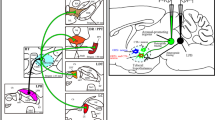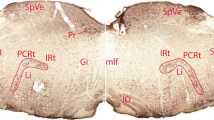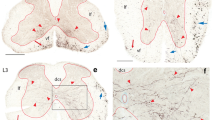Summary
The purpose of this study was to determine ascending and descending afferents to a medullary reticular formation (MRF) site that, when electrically stimulated, evoked EMG activity in lumbar deep back muscles. In anesthetized female rats, the MRF was explored with electrical stimulation, using currents less than 50 μA, while EMG activity was recorded from the ipsilateral lateral longissimus (LL) and medial longissimus (ML). MRF sites that evoked muscle activity were located in the gigantocellular nucleus (Gi). At the effective stimulation site, the retrograde fluorescent tracer, Fluoro-Gold (FG), was deposited via a cannula attached to the stimulating electrode. In matched-pair control experiments, FG was deposited at MRF sites that were ineffective in producing EMG activity in LL and ML, for comparison of afferent projections to effective versus ineffective sites. Labeled cells rostral to FG deposition at effective MRF sites were located in the preoptic area, hypothalamus, limbic forebrain and midbrain, with particularly high numbers in the ipsilateral midbrain central gray, tegmentum, paraventricular nucleus and amygdala. At medullary levels, there was a heavy projection from the contralateral Gi. FG labeled cells were also located in the contralateral parvocellular reticular nucleus, and lateral, medial and spinal vestibular nuclei. Labeled cells with ascending projections were observed in greatest number in the rostral cervical spinal cord, with fewer cells at mid cervical levels and even fewer in the lumbar spinal cord. These labeled cells were located primarily in lamina V, VII, VIII and X. Locations of labeled cells following FG deposition at ineffective MRF sites were similar. However, there was a striking difference in the number of cells retrogradely labeled from the effective MRF sites compared to ineffective MRF sites. Significantly greater numbers of labeled cells were observed in the contralateral MRF, the midbrain, and the cervical spinal cord from the FG deposition at effective stimulation sites. These results suggest that one characteristic of MRF sites that activate epaxial muscles is a larger amount of afferent input, from the midbrain central gray and from contralateral Gi, compared to ineffective MRF sites. Ascending and descending inputs converge at the effective MRF sites, and the larger number of descending projections suggests a more powerful contribution of these afferents to deep lumbar back muscle activation.
Similar content being viewed by others
Abbreviations
- Amyg:
-
amygdala
- Aq:
-
Aqueduct
- C:
-
Cervical spinal cord
- CC:
-
Central canal
- ECu:
-
External cuneate
- F:
-
Fornix
- FG:
-
Fluoro-Gold
- Gi:
-
Gigantocellular reticular nucleus
- GiA:
-
Gigantocellular reticular nucleus, alpha
- GiV:
-
Gigantocellular reticular nucleus, ventral
- icp:
-
inferior cerebellar peduncle
- IO:
-
Inferior olive
- L:
-
Lumbar spinal cord
- LL:
-
Lateral longissimus
- LVN:
-
Lateral vestibular nucleus
- MCG:
-
Midbrain central gray
- ML:
-
Medial longissimus
- ml:
-
medial lemniscus
- MRF:
-
Medullary reticular formation
- MVN:
-
Medial vestibular nucleus
- OT:
-
Optic tract
- PCRt:
-
Parvocellular reticular nucleus
- Pn:
-
Pontine nuclei
- PnO:
-
Pontine reticular nucleus, oral
- PPT:
-
Pedunculopontine tegmental nucleus
- PVN:
-
Paraventricular nucleus
- py:
-
pyramidal tract
- Sol:
-
nucleus of the solitary tract
- Sp5:
-
Spinal trigeminal nucleus
- VMN:
-
Ventromedial nucleus
- 3v:
-
third ventricle
- 7:
-
Facial nucleus
- 12:
-
hypoglossal nucleus
References
Abzug C, Maeda M, Peterson BW, Wilson VJ (1974) Cervical branching of lumbar vestibulospinal axons. J Physiol 243:499–522
Abzug C, Peterson BW (1973) Antidromic stimulation in the pontomedullary reticular formation of local axon branches of contralateral vestibular neurons. Brain Res 64:407–416
Alheid GF, Carlsen J (1982) Small injections of fluorescent tracers by iontophoresis or chronic implantation of micropipettes. Brain Res 235:174–178
Bagshaw EV, Evans MH (1976) Measurement of current spread from microelectrodes when stimulating within the nervous system. Exp Brain Res 25:391–400
Beitz AJ, Mullett MA, Weiner LL (1983) The periaqueductal gray projections to the rat spinal trigeminal, raphe magnus, gigantocellular pars alpha and paragigantocellular nuclei arise from separate neurons. Brain Res 288:307–314
Brink EE, Modianos DT, Pfaff DW (1980) Ablations of lumbar epaxial musculature: effects on lordosis behavior of female rats. Brain Behav Evol 17:67–88
Brink EE, Pfaff DW (1980) Vertebral muscles of the back and tail of the albino rat. Brain Behav Evol 17:1–47
Brink EE, Pfaff DW (1981) Supraspinal and segmental input to lumbar epaxial motoneurons in the rat. Brain Res 226:43–60
Carlson H, Halbert J, Zomlefer M (1979) Control of the trunk during walking in the cat. Acta Physiol Scand 105:251–253
Carlton SM, Leichnete GR, Young EC, Mayer DJ (1982) A transcannula method for subcortical HRP gel implants: inferior olive afferents in the rat. Brain Res Bull 8:581–585
Chaouch A, Mendrey D, Bender D, Besson JM (1983) Neurons at the origin of the medial component of the bulbopontine spinoreticular tract in the rat: an anatomical study using horseradish peroxidase retrograde transport. J Comp Neurol 214:309–320
Cohen MS, Pfaff DW (1984) On-line data acquisition system using an Apple computer: ISI and PST histograms. Brain Res Bull 13:205–223
Cohen MS, Schwartz-Giblin S, Pfaff DW (1987a) Effects of total and partial spinal transections on the pudendal nerve-evoked response in rat lumbar axial muscle. Brain Res 401:103–112
Cohen MS, Schwartz-Giblin S, Pfaff DW (1987b) Brainstem reticular stimulation facilitate back muscle motoneuronal responses to pudendal nerve input. Brain Res 405:155–158
Conde F (1987) Further studies on the use of the fluorescent tracers fast blue and diamidino yellow: effective uptake area and cellular storage sites. J Neurosci Methods 21:31–43
Cottingham SL, Femano PA, Pfaff DW (1987) Electrical stimulation of the midbrain central gray facilitates reticulospinal activation of axial muscle EMG. Exp Neurol 97:704–724
Cottingham SL, Pfaff DW (1987) Electrical stimulation of the midbrain central gray facilitates lateral vestibulospinal activation of back muscles EMG in the rat. Brain Res 421:397–400
Epema A, Gerrits NM, Voogd J (1988) Commissural and intrinsic connections of the vestibular nuclei in the rabbit: a retrograde labeling study. Exp Brain Res 71:129–146
Fahrbach SE, Morrell JI, Pfaff DW (1984) Temporal pattern of HRP spread from an iontophoretic deposit site and description of a new HRP gel implant method. J Comp Neurol 225:605–619
Femano PA, Schwartz-Giblin S, Pfaff DW (1984a) Brainstem reticular influences on lumbar axial muscle activity. I. Effective sites. Am J Physiol 246:R389–395
Femano PA, Schwartz-Giblin S, Pfaff DW (1984b) Brainstem reticular influences on lumbar axial muscle activity. II. Temporal aspects. Am J Physiol 246:R396–401
Fraile IG, McEwen BS, Pfaff DW (1987) Progesterone inhibition of aggressive behaviors in hamsters. Physiol Behav 39:225–229
Fuchs A-R (1969) Uterine activity in late pregnancy and during parturition in the rat. Biol Reprod 1:344–353
Fukuda H, Fukai K (1986) Postural change and straining induced by distension of the rectum, vagina, and urinary bladder of decerebrate dogs. Brain Res 380:276–286
Gallager DW, Pert A (1978) Afferents to brainstem nuclei (brainstem raphe, nucleus reticularis pontis caudalis, and nucleus gigantocellularis) in the rat as demonstrated by microiontophoretically applied horseradish peroxidase. Brain Res 144:257–275
Garcia-Rill E, Skinner RD (1987a) The mesencephalic locomotor region. I. Activation of a medullary projection site. Brain Res 411:1–12
Garcia-Rill E, Skinner RD (1987b) The mesencephalic locomotor region. II. Projections to reticulospinal neurons. Brain Res 411:13–20
Garcia-Rill E, Skinner RD, Conrad C, Mosley P, Campbell C (1986) Projections of the mesencephalic locomotor region in the rat. Brain Res Bull 17:33–40
Gorzalka BB, Lester GLL (1987) Oxytocin-induced facilitation of lordosis behavior in rats is progesterone-dependent. Neuropeptides 101:55–65
Griffin G, Watkins LR, Mayer DJ (1979) HRP pellets and slow release gels: two new techniques for greater localization and sensitivity. Brain Res 168:595–601
Hall RD, Lindholm EP (1974) Organization of motor and somatosensory neocortex in the albino rat. Brain Res 66:23–38
Higuchi T, Uchide K, Honda K, Negoro H (1987) Pelvic neurectomy abolishes the fetus-expulsion reflex and induces dystocia in the rat. Exp Neurol 96:443–455
Hosoya Y, Matsushita M (1981) Brainstem projections from the lateral hypothalamic area in the rat as studied with autoradiography. Neurosci Lett 24:111–116
Hornby JB, Rose DJ (1976) Responses of caudal brainstem neurons to vaginal and somatosensory stimulation in the rat and evidence of genital-nociceptive interactions. Exp Neurol 51:363–376
Jones BE, Yang T-Z (1985) The efferent projections from the reticular formation and the locus coeruleus studied by anterograde and retrograde axonal transport in the rat. J Comp Neurol 242:56–92
Jonsson B (1970) The function of individual muscles in the lumbar part of the spinal muscle. Electromyography 10:5–21
Keizer K, Kuypers HGJM (1984) Distribution of corticospinal neurons with collaterals to lower brain stem reticular formation in cat. Exp Brain Res 54:107–120
Kevetter GA, Willis WD (1983) Collaterals of spinothalamic cells in the rat. J Comp Neurol 215:453–464
Kirchgessner AL, Sclafani A (1988) PVN-hindbrain pathway involved in the hypothalamic hyperphagia-obesity syndrome. Physiol Behav 42:517–528
Kow L-M, Pfaff DW (1982) Responses of medullary reticulospinal and other reticular neurons to somatosensory and brainstem stimulation in anesthetized or freely moving ovariectomized rats with or without estrogen treatment. Exp Brain Res 47:191–202
Krieger MS, Conrad LCA, Pfaff DW (1979) An autoradiographic study of the efferent connections of the ventromedial nucleus of the hypothalamus. J Comp Neurol 183:785–816
Ladpli R, Brodal A (1968) Experimental studies of commissural and reticular formation projections from the vestibular nuclei in the cat. Brain Res 8:65–96
Luiten PGM, ter Horst GJ, Karst H, Steffens AB (1985) The course of paraventricular hypothalamic efferents to autonomic structures in medulla and spinal cord. Brain Res 329:374–378
Lumb BM, Morrison JFB (1986) Electrophysiological evidence for an excitatory projection from the ventromedial forebrain structures onto raphe and reticulo-spinal neurons in the rat. Brain Res 380:162–166
Martin GF, Vertes RP, Waltzer R (1985) Spinal projections of the gigantocellular reticular formation in the rat. Evidence for projections from different areas to laminae I, II, and lamina IX. Exp Brain Res 58:154–162
McGinty P, Szymusiak R (1988) Neuronal unit activity patterns in behaving animals: brainstem and limbic system. Ann Rev Psychol 39:135–168
Menetrey D, Basbaum AI (1987) Spinal and trigeminal projections to the nucleus of the solitary tract: a possible substrate for somatovisceral and viserovisceral reflex activation. J Comp Neurol 255:439–450
Menetrey D, Chaouch A, Besson JM (1980) Location and properties of dorsal horn neurons at origin of spinoreticular tract in lumbar enlargement of the rat. J Neurophys 44:862–877
Modianos DT, Pfaff DW (1977) Facilitation of the lordosis reflex in female rats by electrical stimulation of the lateral vestibular nucleus. Brain Res 134:333–345
Modianos D, Pfaff DW (1979) Medullary reticular formation lesions and lordosis reflex in female rats. Brain Res 171:334–338
Morrell JI, Pfaff DW (1982) Characterization of estrogen-concentrating hypothalamic neurons by their axonal projections. Science 217:1273–1276
Paxinos G, Watson C (1986) The rat brain in stereotaxic coordinates. Academic Press, Orlando FL
Pechura CM, Liu RPC (1986) Spinal neurons which project to the periaqueductal gray and medullary reticular formation via axon collaterals: a double label fluorescence study in the rat. Brain Res 374:357–361
Peterson BW, Pitts NG, Fukushima K (1979) Reticulospinal connections with limb and axial motoneurons. Exp Brain Res 36:1–20
Pfaff DW, Lewis C (1974) Film analyses of lordosis in female rats. Horm Behav 5:317–335
Pfaff DW, Schwartz-Giblin S (1988) Cellular mechanisms of female reproductive behaviors. In: Knobil E, Neill J et al. (eds) The physiology of reproduction. Raven Press Ltd, New York pp 1487–1568
Portillo F, Pasaro R (1987) Axonal projections to the ventrolateral nucleus of the solitary tract revealed by double labeling of retrograde fluorescent markers in the cat. Neurosci Lett 76:280–284
Rye DB, Lee HJ, Saper CB, Warner BH (1988) Medullary and spinal efferents of the pedunculopontine tegmental nucleus and adjacent mesopontine tegmentum in the rat. J Comp Neurol 269:315–341
Sakuma Y, Pfaff DW (1979a) Facilitation of female reproductive behavior from mesencephalic central gray in the rat. Am J Physiol 237:R278-R284
Sakuma Y, Pfaff DW (1979b) Mesencephalic mechanisms for integration of female reproductive behavior in the rat. Am J Physiol 237:R285-R290
Sakuma Y, Pfaff DW (1980a) Cells of origin of medullary projections in central gray of rat mesencephalon. J Neurophys 44:1002–1011
Sawchenko PE, Swanson LW (1982) Immunohistochemical identification of neurons in the paraventricular nucleus of the hypothalamus that project to the medulla or to the spinal cord in the rat. J Comp Neurol 205:260–272
Schmued LC, Fallon JH (1986) Fluoro-Gold: a new fluorescent retrograde tracer with numerous unique properties. Brain Res 377:147–154
Schwanzel-Fukuda M, Morrell JI, Pfaff DW (1984) Localization of forebrain neurons which project directly to the medulla and spinal cord of the rat by retrograde tracing with wheat germ agglutinin. J Comp Neurol 226:1–20
Schwartz-Giblin S, Femano PA, Pfaff DW (1984a) Axial EMG and intervertebral length gauge responses during lordosis behavior in rats. Exp Neurol 85:297–315
Schwartz-Giblin S, Halpern M, Pfaff DW (1984b) Segmental organization of rat lateral longissimus, a muscle involved in lordosis behavior: EMG and muscle nerve recordings. Brain Res 299:247–257
Shapovalov AI, Gurevitch N (1970) Monosynaptic and disynaptic reticulospinal actions on lumbar motoneurons of the rat. Brain Res 21:249–263
Siegel JM, Tomasiewski KS (1983) Behavioral organization of reticular formation: studies on the unrestrained cat. I. Cells related to axial, limb, eye and other movements. J Neurophysiol 50:696–717
Sirkin DW, Feng AS (1987) Autoradiographic study of descending pathways from the pontine reticular formation and the mesencephalic trigeminal nucleus in the rat. J Comp Neurol 256:483–493
Smith OA, DeVito JL (1984) Central neural intergration for the control of autonomic responses associated with emotion. Ann Rev Neurosci 7:43–65
Sofroniew MV, Schrell U (1981) Evidence for a direct projection from oxytocin and vasopressin neurons in the hypothalamic paraventricular nucleus to the medulla oblongata: immunohistochemical visualization of both the horseradish peroxidase transported and the peptide produced by the same neurons. Neurosci Lett 22:211–217
Sullivan J, Schwartz-Giblin S, Pfaff DW (1986) Correlations between EEG state and spontaneous and evoked axial muscle EMG. Brain Res 368:197–200
Swanson LW, Kuypers HGJM (1980) The paraventricular nucleus of the hypothalamus: cytoarchitectonic subdivisions and the organization of projections to the pituitary, dorsal vagal complex and spinal cord as demonstrated by retrograde fluorescence double-labeling methods. J Comp Neurol 194:555–570
Van der Kooy D, Koda L, McGinty JF, Gerfen CR, Bloom F (1984) The organization of the projections from the cortex, amygdala and hypothalamus to the nucleus of the solitary tract in rat. J Comp Neurol 224:1–24
Wise SP, Jones EG (1977) Cells of origin and terminal distribution of descending projections of the rat somatic sensory cortex. J Comp Neurol 175:129–158
Zemlan FP, Behbehani MM, Beckstead RM (1984) Ascending and descending projections from the nucleus magnocellularis and reticularis gigantocellularis: an autoradiographic and horseradish peroxidase study in the rat. Brain Res 292:207–220
Zemlan FP, Leonard CM, Kow L-M, Pfaff DW (1978) Ascending tracts of the lateral columns of the rat spinal cord: a study using the silver impregnation and horseradish peroxidase techniques. Exp Neurol 62:298–334
Zilles K, Wree A (1985) Cortex: areal and laminar structure. In: Paxinos G (ed) The rat nervous system, Vol 1. Academic Press, San Diego, pp 375–415
Zimmerman EA, Chambers WW, Liu CH (1964) An experimental study of the anatomical organization of the cortico-bulbar system in the albino rat. J Comp Neurol 123:301–324
Zomlefer MR, Provencher J, Blanchette G, Rossignol S (1984) Electromyographic study of lumbar back muscles during locomotion in acute high decerebrate and in low spinal cats. Brain Res 290:249–260
Author information
Authors and Affiliations
Rights and permissions
About this article
Cite this article
Robbins, A., Schwartz-Giblin, S. & Pfaff, D.W. Ascending and descending projections to medullary reticular formation sites which activate deep lumbar hack muscles in the rat. Exp Brain Res 80, 463–474 (1990). https://doi.org/10.1007/BF00227988
Received:
Accepted:
Issue Date:
DOI: https://doi.org/10.1007/BF00227988




